published on July 20, 2014
PAGE TOPICS
New World Order after New Order of the Mass
The Revolutions of the 1960's after the Second Vatican Council
Drugs, Sex, Rock N Roll
IMPORTANT NOTE
This page discusses the relationship between the New Order of the World and of the Church. Our desire and intent of this page should not be taken as an insult or attack in any way on the Catholic Church and/or any person from within or without it. This page is not meant to judge the past choices made by the Roman Catholic Clergy, but to simply heighten awareness, discussion, and discernment. We have made use of concrete documentation and written history of events to report the absolute truth.
As always, we invite people of all backgrounds to read the following content: whether you are a Catholic or a non-Catholic; whether you believe in God or not – we welcome you all with love.
God Bless ~
The NEW WORLD ORDER after the NEW ORDER OF THE MASS
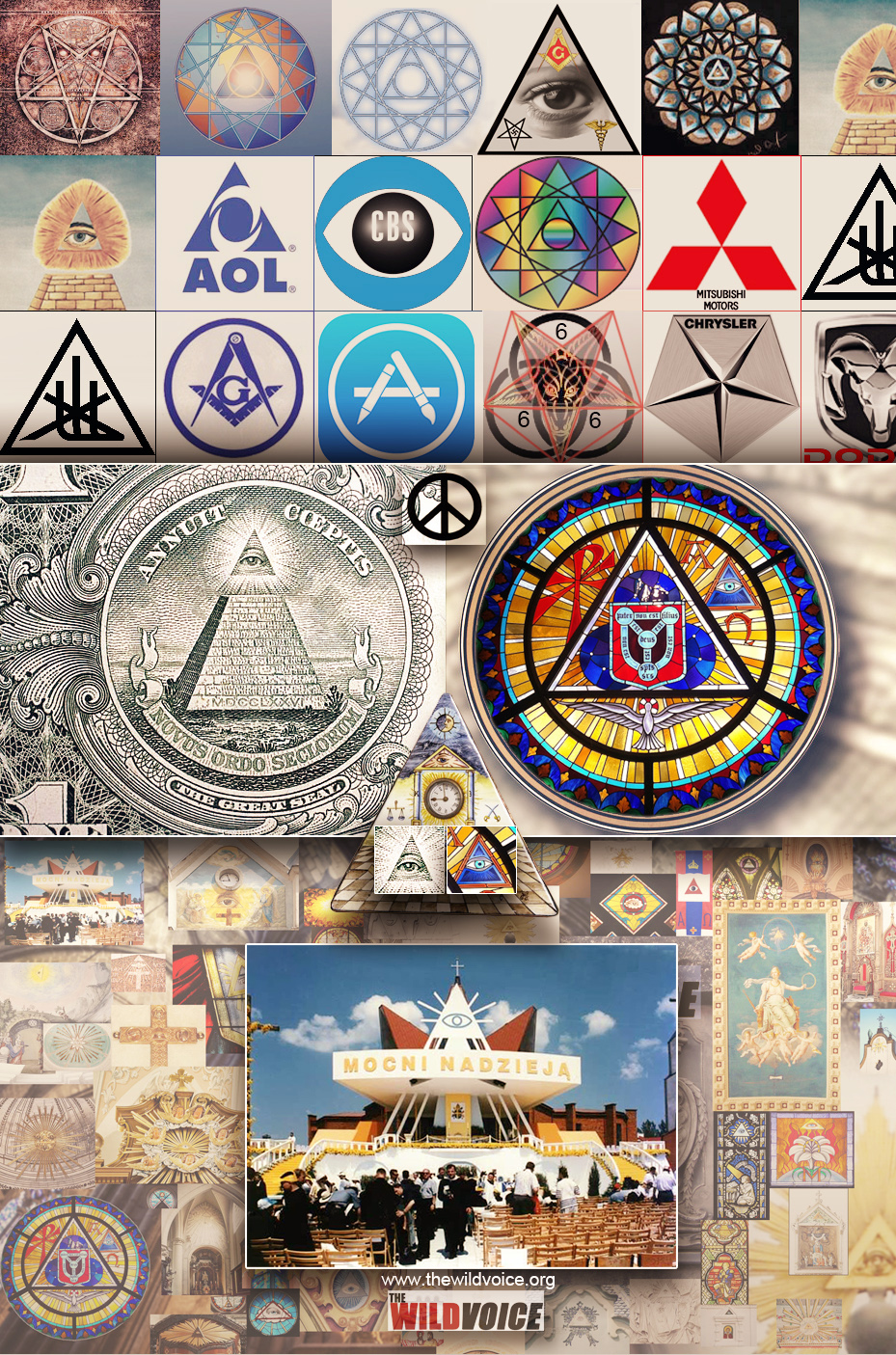
In this page, we will try our best to put together the many pieces of a very complex puzzle which finds its roots somewhere in ancient history. While it would take thousands more pages to reveal the depth of such vortex, we will limit ourselves to giving a faithful overview of proven facts as well as their deeper spiritual and occultist sub-layers. We understand that the mention of occult, satanic, masonic, pagan or other 'dark' practices can seem conspiratorial and unrealistic; they can even be discarded as amusing by the media or by the average person who will only care about some TV show reruns while, in the case of 'cafeteria Catholics', such connections are found to be almost unjustifiable blasphemies.
No matter the personal opinion of every single individual, the truth of the events that took place during the 20th century is reported in the following chapters as "The Revolutions of the 1960s".
These were the first steps of the unifying process between secular and sacred which might reach its successful end result under the current papacy of Francis I.
THE REVOLUTIONS of the 1960s: The SECOND VATICAN COUNCIL
(Vatican II)
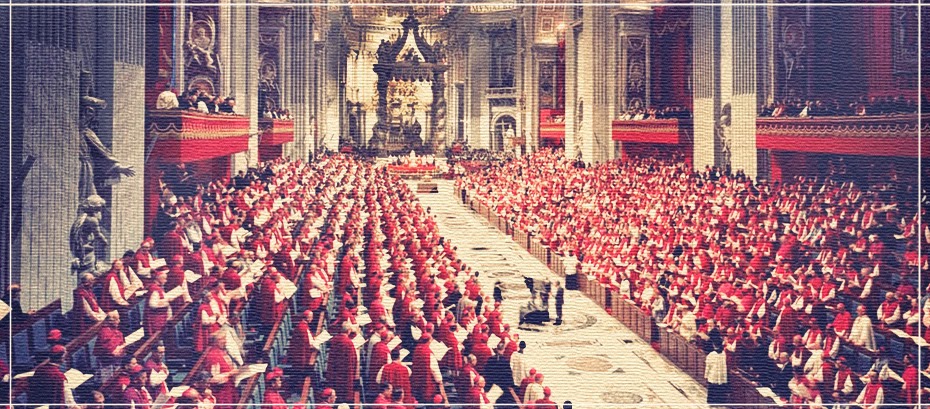 On 25 January, 1959, Pope John XXIII and 18 Cardinals met for a service at Rome's 'Basilica of Saint Paul Outside The Walls' to conclude the Octave of Prayer for Christian Unity. In a brief address, the Pope announced that he intended to summon an ecumenical council (a council of all the bishops of the Catholic Church), adding at the end a prayer for "a renewed invitation to the faithful of the separated communities that they also may follow us amiably in the search of unity and grace, to which so many souls aspire in all parts of the earth."
On 25 January, 1959, Pope John XXIII and 18 Cardinals met for a service at Rome's 'Basilica of Saint Paul Outside The Walls' to conclude the Octave of Prayer for Christian Unity. In a brief address, the Pope announced that he intended to summon an ecumenical council (a council of all the bishops of the Catholic Church), adding at the end a prayer for "a renewed invitation to the faithful of the separated communities that they also may follow us amiably in the search of unity and grace, to which so many souls aspire in all parts of the earth."
The newly elected Pope John XXIII told the 18 Cardinals that he planned to summon a 'global church council'. The horrified cardinals were speechless, which the Pope mischievously chose to interpret as devout assent. In reality, the Vatican bureaucrats known as the Curia, found such intention to be abhorrent. The 77-year-old Pope had been elected purely as a caretaker and yet, he was indulging an innovative, unpredictable, dangerous and (above all, they believed) unnecessary notion. In their view, such notion would create ungovernable expectations and lead to changes. And if there were to be changes – always undesirable – then the Curia would manage them without any outside intervention, as they had done for centuries.
Therefore, they regrouped and fought back: if they could not avoid the council, then they would control it. They proposed 10 commissions controlled by Curia members to run the council, which would discuss 70 documents prepared by the Curia themselves.
But the world's bishops, led by a generation of outstanding European theologians, were in no mood to submit and simply sidestepped the careful preparation while arranging their own agendas.
The Curia were right to worry: what Pope John unleashed, now known as Vatican II, was the most momentous religious event since Martin Luther launched the Protestant Reformation 450 years earlier.
"It was a revolution" says American theologian John Markey. "It was the most fundamental shift in self-understanding by the church in 1500 years. It is not over yet".
The goals of the council were explained by the pope, who longed for an aggiornamento (Italian for "bringing up to date') of the Catholic Church. It is reported that Pope John XXIII once described the council's purpose as 'going to the nearest window and opening it to let in some fresh air'.
But it was in Christian unity that the primary aim of the council was to be found by establishing a new Vatican Congregation, the Secretariat for Promoting Christian Unity charged with bringing the Catholic Church into the ecumenical movement.
In his official opening speech, the Vicar said that the Council was not going to discuss the doctrine, but that questions would be 'studied and expounded through the methods of research and through the literary forms of the modern thought'. In other words, the Church was going to look at (and express) Christ's Teachings in a renewed way. His most famous remark is: 'The substance of the ancient doctrine of the deposit of faith is one thing, and the way in which it is presented is another'. That fact had not always been obvious to Catholics.
The subjects that were presented in a different way to suit modern knowledge and understanding were the following:
- The Church
- Revelation
- The Liturgy
- Ecumenism
- Religious Freedom
- Non-Christian religions
- The Church and the modern world
The Second Vatican Council, through the Holy See, formally opened under the pontificate of Pope John XXIII on 11 October 1962 and closed under Pope Paul VI on the Feast of the Immaculate Conception in 1965. The council became ideally known for its renewal of Catholic doctrine in a modern timeline and perspective. They met in four sessions from (1962 to 1965) and produced 16 documents: each one was a treatise, a manifesto, setting out the church's thinking and future direction in a specific area.
Several institutional changes resulted from the council, such as:
- The renewal of consecrated life with a revised charism, and – The ecumenical efforts towards dialogue with other religions – The notion of the Catholic Church alone brings through ultimate salvation to mankind
- The expressive participation of laity in various religious activities.
- The widespread use of vernacular language in Holy Mass instead of the Latin language
- The displacement of the Church tabernacle from the central aisle
- The revision of Eucharistic prayers
- The celebration Versus Populum instead of Ad Orientem
- The abbreviation of the liturgical calendar
- The modern aesthetic changes encompassing contemporary Catholic liturgical music and artwork (mostly all which remain divisive and polemic among the Catholic faithful until the present day).
The winds of change proved more like a tornado, leaving almost nothing untouched. It is difficult for us, people of today, to grasp how radical, how wide-ranging and how deep the effects were because we have no memory of the pre-council church defined as 'frozen in a time warp', as Jesuit priest Gerald O'Collins told The Age.
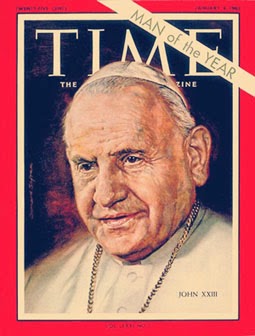 Pope John XXIII intended the church to emerge from behind the battlements, lower the drawbridge and engage with the modern world. The most obvious and visible change for Catholics in the pew was worship in their own language rather than in Latin, with the priest now facing them rather than the altar, the affirmation of the role of laypeople and, thanks to Jesuit priest Joseph Gelineau, the change of liturgical music from the Gregorian Chants to 1960s folk songs. But there were other profound developments such as a willingness to engage with other churches and faiths; a renewed focus on social justice; a decentralised approach to authority in the church.
Pope John XXIII intended the church to emerge from behind the battlements, lower the drawbridge and engage with the modern world. The most obvious and visible change for Catholics in the pew was worship in their own language rather than in Latin, with the priest now facing them rather than the altar, the affirmation of the role of laypeople and, thanks to Jesuit priest Joseph Gelineau, the change of liturgical music from the Gregorian Chants to 1960s folk songs. But there were other profound developments such as a willingness to engage with other churches and faiths; a renewed focus on social justice; a decentralised approach to authority in the church.
Today, as religious culture wars between traditionalists and progressives rack the church in the West, Vatican II has become the key battlefield. Both sides want to define and control the council's legacy. Progressives accuse traditionalists, who have had the huge political advantage of having the past two Popes among their number, of trying to wind back the liberalizing reforms by stifling important debates and reimposing a strict top-down control of both practice and belief. Traditionalists counter that progressives want the church to conform to the ever-changing spirit of the times.
On the understanding that Vatican II 'wrecked the faith of a generation', theologian Tracey Rowland says: 'While Catholics were trying desperately to be modern, the rest of the world was becoming bored with modernity and turning postmodern". Others found the council and its fruits inspirational: for Bob Dixon, a teenager in Ballarat in the late 1960s, it connected his faith with the world. He was a child of the pre-Vatican II church which, with its fixed certainties and emphasis on sin and grace, was now often condemned as a fear-based approach to religion. "But I suddenly began to see that faith was about life and the world and society and social justice" says Dixon, now one of the Australian church's most important laypeople in his position as head of the national Pastoral Projects Office. Young Australian priests who were in Rome for some of the sessions, such as George Pell — now Cardinal Pell, Archbishop of Sydney — and Michael Costigan, who began his later career as a journalist by posting home reports, were swept up in the enthusiasm. Catholic confidence was high, Pell recalls. "It was an enormously exciting time, a time of great intellectual ferment. We were caught up in this great movement of reform, and we were wildly over-optimistic".
It is very interesting to know that much (if not all) of the changes reached within the Catholic Church since the Second Vatican Council can be read on a booklet called Alta Vendita.
The Permanent Instruction of the Alta Vendita (commonly called the Alta Vendita) is a document, originally published in Italian in the 19th century, purportedly produced by the highest lodge of the Italian Carbonari. The manuscript details an alleged Masonic plan to infiltrate the Catholic Church and spread liberal ideas within it. The Carbonari had strong similarities to Freemasonry, therefore the document is seen by many as a Masonic document. In the 19th century, Pope Pius IX and Pope Leo XIII both asked for it to be published. It was first printed and divulged by Jacques Crétineau-Joly in his book 'L'Église Romaine en face de la Révolution' in 1859. It was popularized in the English-speaking world by Monsignor George F. Dillon in 1885 with his book 'The War of Anti-Christ with the Church and Christian Civilization'. Today it is still consulted by those Catholics who are aware of the changes made within the church during the post-Vatican II era. The accuracy of the content makes The Permanent Instruction of the Alta Vendita an undeniable proof of the Masonic plan to destroy Christianity, which is now approaching its final stage.
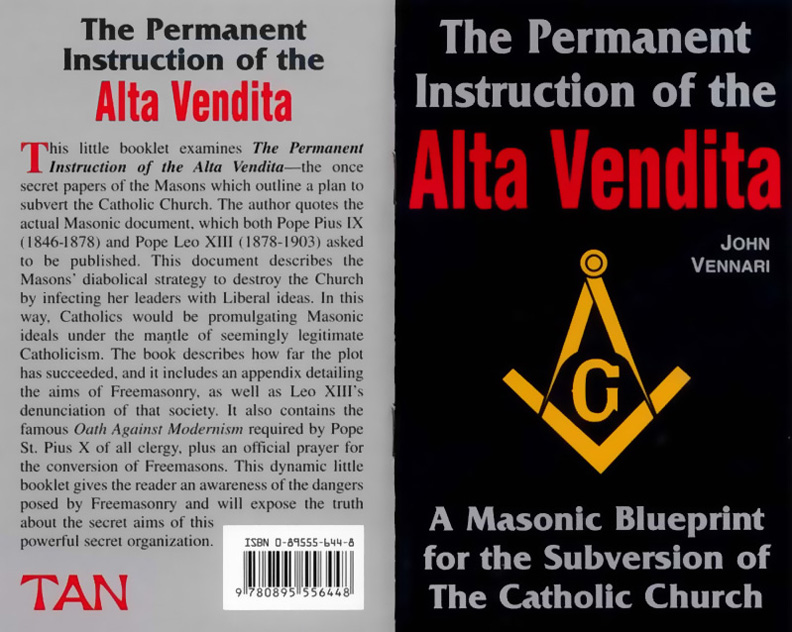
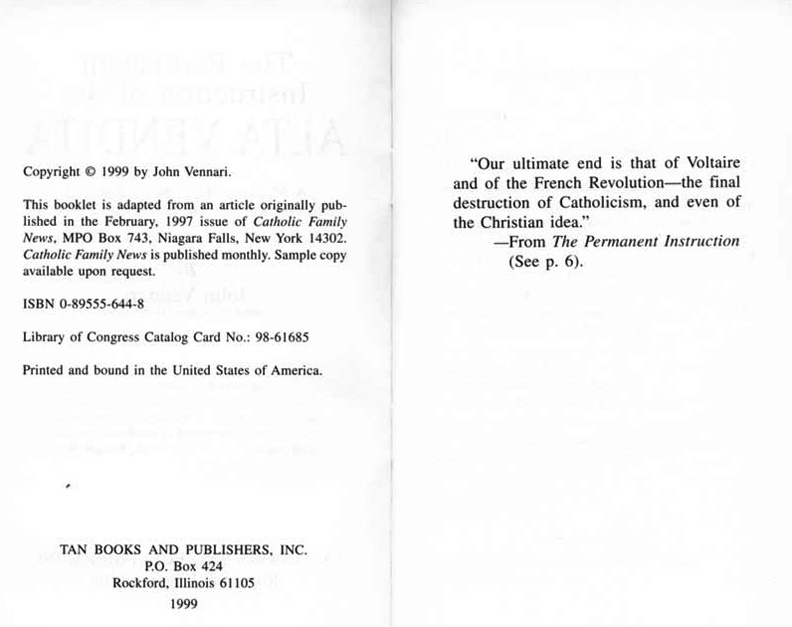
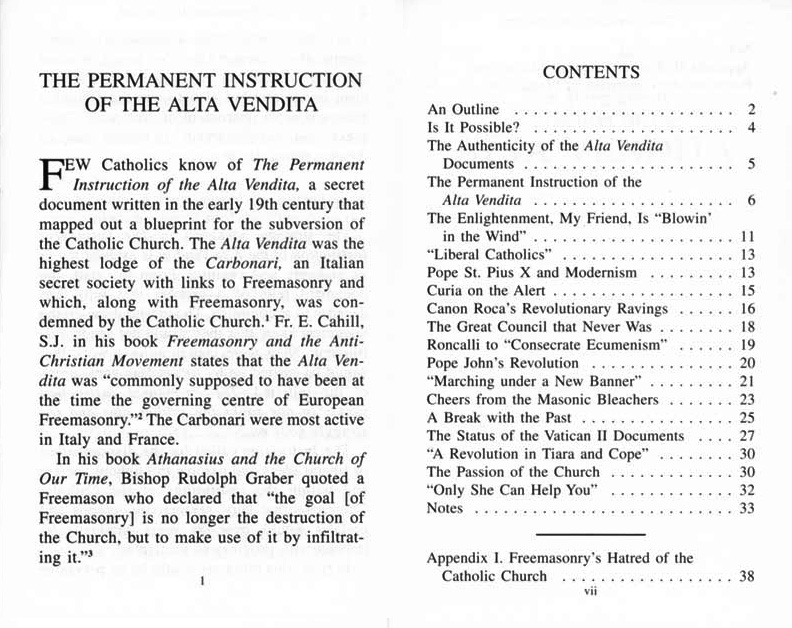
THE REVOLUTIONS of the 1960s: DRUGS, SEX and ROCK' N ROLL

Perfectly coinciding with the beginning and the end of the Second Vatican Council revolution was the world's revolution of the 1960s: the rock' n roll revolution, the feminism revolution, the gay revolution, the sexual revolution, the traditional modes of authority revolution and the drugs revolution. This phenomenon is known as Counterculture, which brought about the birth of further sub-branches which reached us in today's culture. As the result of the Church changes, society's rebellion exploded and found a wide freeway towards immorality: sex, drugs, rock, feminism, homosexuality, materialism and social chaos. Those revolutions have led to today's hypocritical liberalism used by governments to control the freedom of citizens through the gradual destruction of the nations' constitutions. An example is the boycotting that gay lobbies constantly create on people (and companies) who peacefully express their opinion on homosexuality in concordance with the First Amendment of the American Constitution (which grants the absolute right to freedom of speech and opinion).
It is no secret that the world revolution and the church revolution were no fruit of mere coincidence: the masonic lobbies penetrating (and reinforcing their positions within) the Catholic Church, the media and the governments worked as a team to achieve the following:
- The erosion of morality by 'freeing' society from the strict laws of the Bible.
- The watering down of Christ's teaching by uniting religious creeds.
- The brainwashing of every level of society through music, movies, television, radio, magazines, newspapers and other media outlets.
- The erase of social boundaries achieved through the use of propaganda in the name of human rights and intolerance (in regards to women, homosexuality, women's emancipation and right to vote, divorce and more).
- The rebellion against social-political and religious authority in the name of anarchy.
- The destruction of society at its root through the promotion of divorce, women emancipation, abortion as women's right, premarital sex and single motherhood.
By the end of the Second Vatican Council in 1965, the entire world was about to tilt on its axis. The council was planned to come during – and to promote– the huge social changes due to the rise of feminism, the explosion of the sexual revolution, the shifting focus from community to individualism, the different attitude towards authority and the gay liberation movement. It is no conspiracy that the mass media played a huge role into controlling the globe's population; Wikipedia, in fact, states that 'TV, the new mass communication device of the age, along with other media outlets such as radio and magazines, could broadcast information in a matter of seconds to millions of people, while only a few wealthy people would control what millions could watch. Some modern historians have theorized that these media outlets helped to spread new ideas, which were considered radical. The struggles, skirmishes and rhetorical confrontations happening in the course of these movements also became directly visible to ordinary people in a way they would never have been before; the sense of involvement in a social and sexual shift happening in the present could rapidly win new converts and spread discussions afield. The counterculture of the 1960s was becoming well-known through radio, newspapers, TV, books, music and other media by the end of the 1960s'.
This time brought with it the dramatic increase in drug use amongst the youth: according to the US National Library of Medicine of the National Institutes of Health, in 1959 there were just 47 known heroin addicts; by 1964 this had risen to 328. More significantly, the population of addicts seemed to be changing: firstly, addicts were younger: in 1964, 40% were below the age of 35 compared with 11% in 1959. Heroin, cocaine, Marijuana and LSD became entwined with a new vision of human sexuality (as a mean to societal and personal freedom) and of new age spiritualism descending from Russian occultist Helena Petrovna Blavatsky. Sex and drugs were promoted through music, both directly and indirectly. The Rock revolution brought a new wave of thoughts, philosophies and mentalities that broke from all that was 'traditional and religious': they spoke about drugs and sex, although not always openly. In the nineteen sixties, "Do your own thing" became a common expression. It meant to do whatever you wanted, without feeling guilty: Do what thy wilt. Such expression came from a man who proclaimed himself to be the Beast 666 and whose name was Aleister Crowley. He was a British Satanist and Freemason, was also a devotee of the triangle as symbol. As a high-level officer of the occult group, Order of the Golden Dawn, Crowley used for one of his emblems the Eye of Horus in the Pyramid of Fire, radiated by the sun's rays. Bands like the Beatles followed Crowley's occult theories and contributed to the spread of 'new ways' hidden behind the mask of freedom, peace and love.
The raise of spiritualism and the occult in the Illuminati Counterculture Movement planned by the sects present within the Churches (including the Vatican) and within the secular worlds.
Many hippies rejected mainstream organized religion in favor of a more personal spiritual experience, often drawing on indigenous and folk beliefs. If they adhered to mainstream faiths, hippies were likely to embrace Buddhism, Unitarian Universalism, Hinduism and the restorationist Christianity of the Jesus Movement. Some hippies embraced neo-paganism, especially Wicca and New Age. To see more on the New Age movement, click here. In his 1991 book 'Hippies and American Values', Timothy Miller described the hippie ethos as essentially a 'religious movement' which goal was to transcend the limitations of mainstream religious institutions. "Like many dissenting religions, the hippies were enormously hostile to the religious institutions of the dominant culture, and they tried to find new and adequate ways to do the tasks the dominant religions failed to perform."
In his seminal, contemporaneous work 'The Hippie Trip', author Lewis Yablonsky notes that those who were most respected in hippie settings were the spiritual leaders, the so-called 'high priests' who emerged during that era.
One such hippie 'high priest' was San Francisco State University Professor Stephen Gaskin. Beginning in 1966, Gaskin's 'Monday Night Class' eventually outgrew the lecture hall and attracted 1,500 hippie followers in an open discussion of spiritual values, drawing from Christian, Buddhist, and Hindu teachings. In 1970 Gaskin founded a Tennessee community called 'The Farm', and he still lists his religion as 'Hippie'.
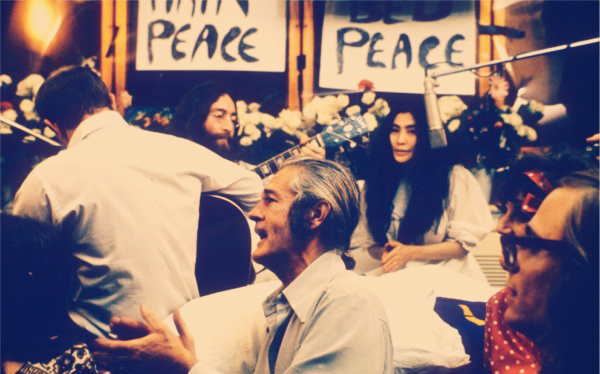 Timothy Leary was an American psychologist and writer, known for his advocacy of psychedelic drugs. On September 19, 1966, Leary founded the League for Spiritual Discovery, a religion declaring LSD as its holy sacrament. The Psychedelic Experience was the inspiration for John Lennon's song 'Tomorrow Never Knows' in The Beatles' album Revolver. He also published a pamphlet in 1967 called 'Start Your Own Religion'.
Timothy Leary was an American psychologist and writer, known for his advocacy of psychedelic drugs. On September 19, 1966, Leary founded the League for Spiritual Discovery, a religion declaring LSD as its holy sacrament. The Psychedelic Experience was the inspiration for John Lennon's song 'Tomorrow Never Knows' in The Beatles' album Revolver. He also published a pamphlet in 1967 called 'Start Your Own Religion'.
As we already mentioned, the English black magician Aleister Crowley became an influential icon to the new alternative spiritual movements of the decade as well as for rock musicians. The Beatles included him as one of the many figures on the cover sleeve of their 1967 album 'Sgt. Pepper's Lonely Hearts Club Band' while Jimmy Page, the guitarist and co-founder of 1970s rock band Led Zeppelin was fascinated by Crowley, and owned some of his clothing, manuscripts and ritual objects, and during the 1970s bought Boleskine House, which also appears in the band's movie 'The Song Remains the Same'. On the back cover of The Doors '13 album', Jim Morrison and the other members of the Doors are shown posing with a bust of Aleister Crowley. Timothy Leary openly acknowledged the inspiration of Aleister Crowley. In the 1960s Anton LaVey, who was also influenced by Crowley, formed a group called the 'Order of the Trapezoid', which later became the governing body of the Church of Satan. The Church of Satan was the subject of a number of books, magazine and newspaper articles during the 1960s and 1970s. Commenting on the work of his friend H. R. Giger, a surrealist artist from Switzerland who won an Academy Award for his work on the film Alien, Leary noted: "Giger’s work disturbs us, spooks us, because of its enormous evolutionary time span. It shows us, all too clearly, where we come from and where we are going". Here are two works from H. R. Giger:
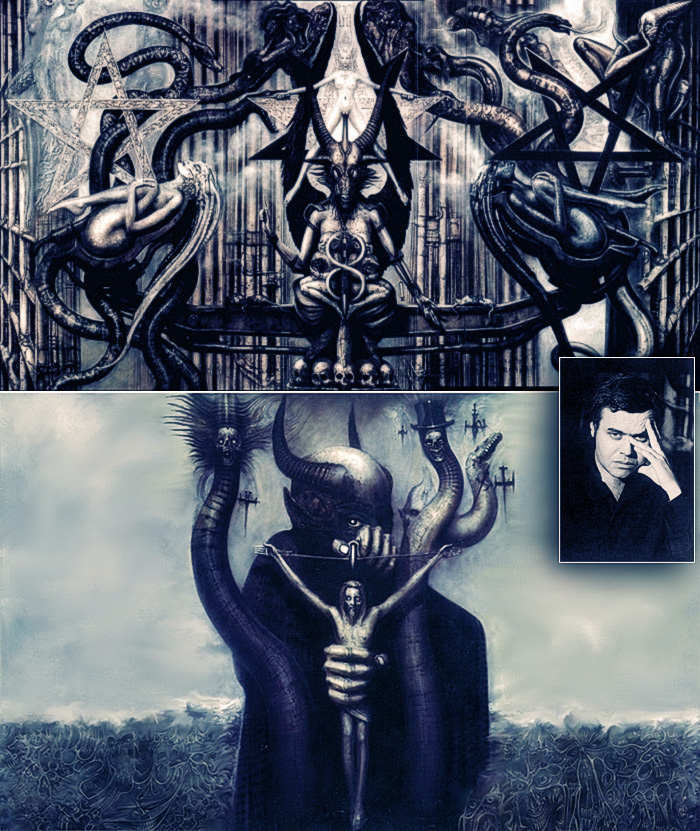
During those same years, another man rose to success: Charles Manson. During 1967's 'Summer of Love', he was emerging as the signature hippie locale having borrowed philosophically from the 'Process Church', whose members worshiped Satan. Expounding a philosophy that included some of the Scientology he had studied earlier, he soon had the first of his groups of followers, which have been called the Manson Family, most of them female. Indeed, upon a staff evaluation of Manson when he entered prison in July 1961 at the U.S. penitentiary in McNeil Island (Washington), Manson entered 'scientologist' as his religion. As we all know, he (and 'his family') were responsible for the atrocious murder of Sharon Tate on August 9, 1969. Her husband, Roman Polanki (who later on was accused of raping an underage woman at Jack Nicholson's home) was 'suspiciously' out of town when the crime occurred. It is interesting to note that only two years prior to the murder, Polanki released a movie called 'Rosemary's Baby', a psychological horror story about the unsuspected ramifications of Satanism within the bourgeoisie and upper-class Manhattan society as well as the entertainment industry. The victim of such hidden Luciferian network is played by Mia Farrow who is impregnated against her will to bring about the Antichrist. The plot takes place in 1966, the year of the founding of the Church of Satan led by Anton LaVey who is also in the movie, portraying the devil. The building in which the young victim lived is the same one where John Lennon resided and was murdered in front of in 1980. Coincidences? It is hard to understand the mysteries behind the intricate occult world of the New Age of Satanism that sprung from the serpent which found an open gate by the voluntary rejection of Saint Michael the Archangel's protection of the Catholic Church and of the world.
Indeed (just as they brought about the birth of the Antichrist in the 1966 movie just mentioned) the masonic forces controlling the religious institutions, the banking system and the political organizations were able to bring the New Age to a real birth: the 'Novus Ordo Seclorum', known also as the New Order of the Ages, the New Order of Paganism or the New World Order (the last one not being a literal translation from Latin). This denomination has been used on the reverse side of the Great Seal since 1782 and on the back of the one-dollar bill since 1935 right below the masonic pyramid generally attributed to the Order of the Illuminati. Let's not forget that the pyramid was (and still is) the symbol of slavery: its all-seeing eye on top represents Lucifer's control over the masses while the three sides of the triangle (the pyramid) also signifies the satanic trinity.
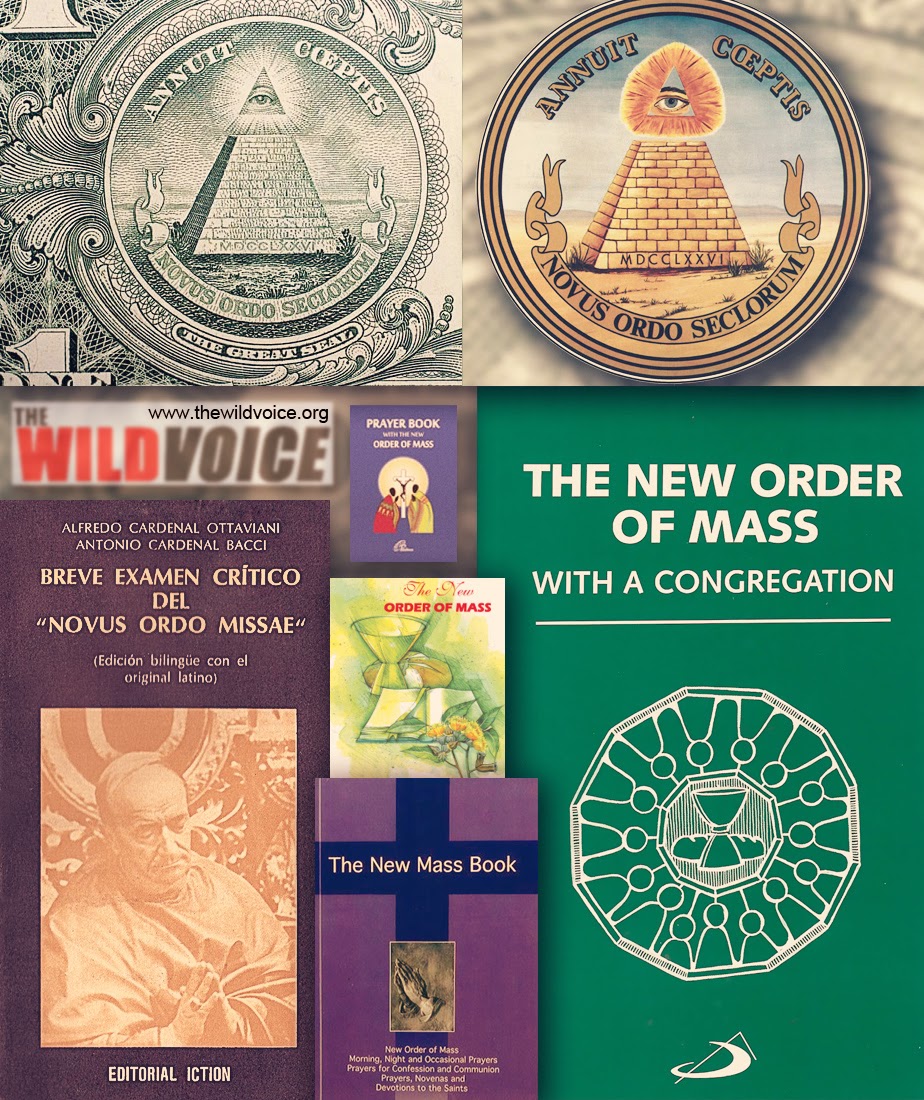
In the image above, it is absolutely clear that VATICAN II opened the first spiritual door of the NEW WORLD ORDER through a NEW ORDER OF THE MASS. The so-called NOVUS ORDO SECLORUM and the NOVUS ORDO MISSAE represent the SECULAR and the RELIGIOUS steps toward the future Kingdom of the Antichrist. To further increase the satanic and masonic forces into the Holy Catholic and Apostolic Church of Jesus Christ, a shocking decision was taken for no specific and justifiable reason: the Saint Michael the Archangel Prayer was abolished from the Sacrifice of the Mass (now erroneously called 'the celebration' of the Mass). Such prayer was composed by Pope Leo XIII after a vision he was given. Such vision occurred on October 13, 1884, exactly 33 years to the day prior to the great Miracle of the Sun in Fatima on October 13, 1917. When the aged Pontiff had finished celebrating Mass in his private Vatican Chapel, attended by a few Cardinals and members of the Vatican staff, he suddenly stopped at the foot of the altar. He stood there for about 10 minutes, as if in a trance, his face ashen white. Then, going immediately from the Chapel to his office, he composed the prayer to St. Michael, with instructions it be said after all Low Masses everywhere. When asked what had happened, he explained that, as he was about to leave the foot of the altar, he suddenly heard voices – two voices, one kind and gentle, the other guttural and harsh. They seemed to come from near the tabernacle. As he listened, he heard the following conversation:
The voice of Satan boasted to Our Lord: "I can destroy your Church!"
The gentle voice of Our Lord said in reply: "You can? Then go ahead and do so."
Satan answered: "To do so, I need more time and more power."
Then, Our Lord asked him: "How much time? How much power?"
To this, Satan replied: "75 to 100 years, and a greater power over those who will give themselves over to my service."
Finally, Our Lord said: "You have the time, you will have the power. Do with them what you will."
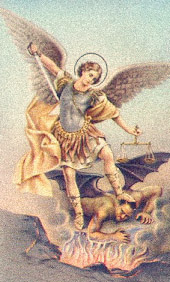 This happened in 1884. The devil said he needed 75 to 100 years. Well, 75 years from 1884 is 1959: it was, indeed, on January 25, 1959, that John XXIII publicly summoned the Second Vatican Council. Remember that after the vision, Pope Leo XIII immediately wrote the Prayer to St. Michael to help us overcome the devil in his quest. He instructed that it be said after every low Mass. One of the first changes to come from Vatican II, was the deletion of the Leonine Prayers which included the prayer to St. Michael. These prayers were eliminated in 1964, the 80th year of the devils 75 – 100 years needed to destroy the Catholic Church. It would seem that this would be the time to especially say that prayer, not to delete it.
This happened in 1884. The devil said he needed 75 to 100 years. Well, 75 years from 1884 is 1959: it was, indeed, on January 25, 1959, that John XXIII publicly summoned the Second Vatican Council. Remember that after the vision, Pope Leo XIII immediately wrote the Prayer to St. Michael to help us overcome the devil in his quest. He instructed that it be said after every low Mass. One of the first changes to come from Vatican II, was the deletion of the Leonine Prayers which included the prayer to St. Michael. These prayers were eliminated in 1964, the 80th year of the devils 75 – 100 years needed to destroy the Catholic Church. It would seem that this would be the time to especially say that prayer, not to delete it.
The reinforcement of the power of evil sects such as the Illuminati within the Catholic Church through the Second Vatican Council was just that: in fact, such orders had invaded the Church for centuries. These are the words of the Mother of Salvation, given to Maria Divine Mercy in The Book of Truth:
"This sect is known to exist among those sacred servants within the Vatican, yet they are powerless against this evil group, which has infiltrated the Catholic Church for centuries. They are responsible for twisting the Truth of my Son’s Teachings. So little is known about them or their vile works. They have driven the True Doctrine from the Catholic Church and, in its place a lukewarm, watered down version has been force-fed to Catholics over the last forty years".
Mother of Salvation's message from Wednesday, January 18th, 2012 given to Maria Divine Mercy
Let us look at this image. The proof that these sects have been present within the walls of the Vatican palace is clear in the constant use of the triangle: the pyramid of the Illuminati. The same symbol also appears on the one dollar bill, in the logos of many corporations and in the entertainment business.
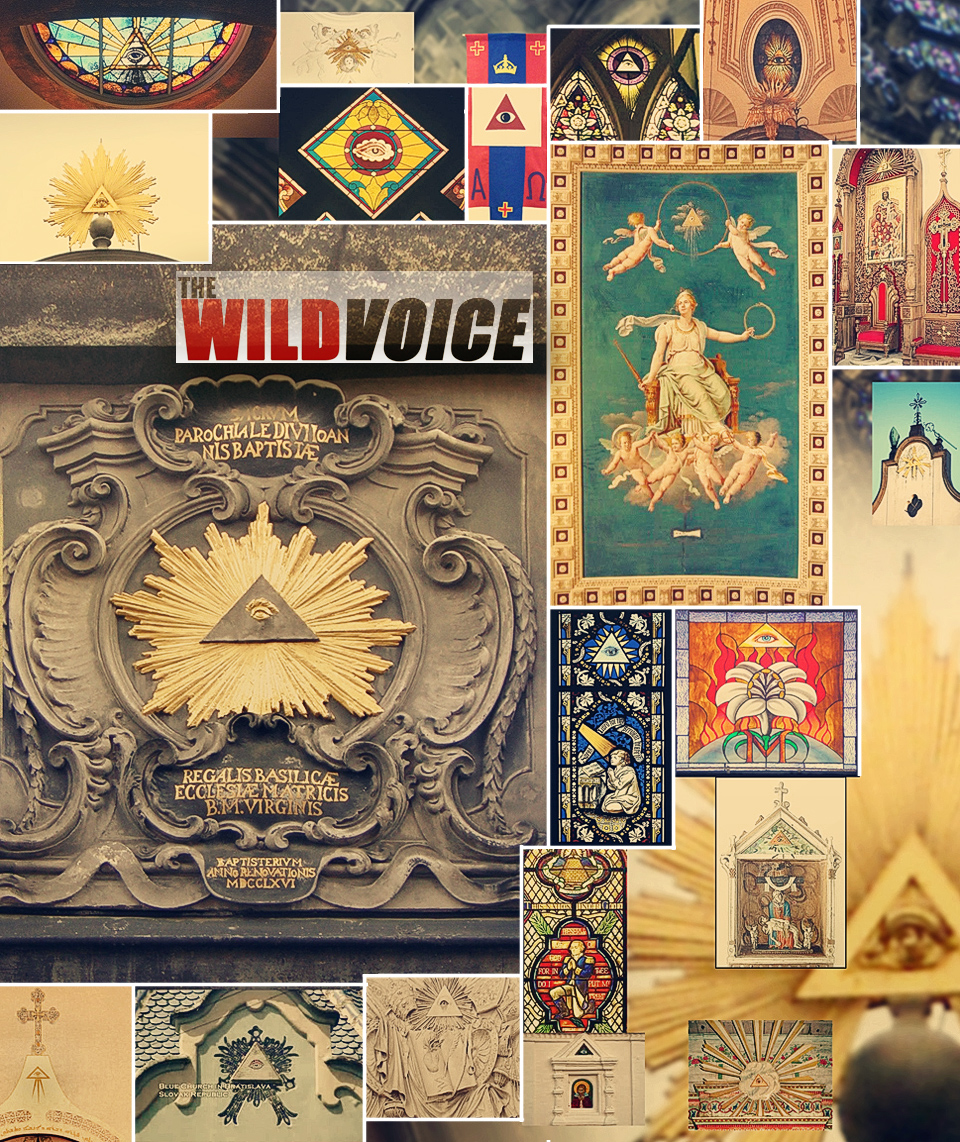
These sects, under the triangle, were determined to begin a new age of fraternity, tolerance, liberty, entitlement, equality and modernism away from the authority of the True God whose laws began to be perceived as old fashion, imposing, limiting and unjust towards human beings. 'There was a renewed emphasis on social justice as part of the Christian life alongside personal piety, and laypeople were explicitly recognized as having a central role in the mission of the church. Vatican authority was reduced in favor of a greater autonomy for local bishops and a more collegial approach'. (Daniel Cassidy)
In regards to the changes imposed by the Second Vatican Council, here are the words given to Maria Divine Mercy by Jesus Christ:
"My daughter, please pray for My Vicar, Pope Benedict, for he is surrounded by masonic forces who are now making every effort to dethrone him, these evil forces have been infiltrating My Church since Vatican II and have diluted My Teachings. Many laws were passed which offend Me, especially the presentation of My Holy Eucharist by lay people. The lack of respect shown to Me and My Eternal Father, through new laws introduced to facilitate modern society has made Me cry with sadness. The Most Holy Eucharist must be received on the tongue and not soiled by human hands. Yet this is precisely what My sacred servants have done. These laws were not passed by Me in Spirit. My sacred servants have been led down a path not in line with the Teachings of My apostles. Today My Sacraments are not taken very seriously, especially those who seek the Sacraments of Matrimony and the First Holy Communion"
Jesus's message given to Maria Divine Mercy on Wednesday, July 6th, 2011
Sadly (especially after having read the Lord's quote here above) Robert Blair Kaiser, who covered the council for Time Magazine, suggested that "Rather than whine over what daddy won't let us do, Catholics should be grateful for what the council did achieve, and build on that themselves. It has given us a new view of ourselves. It's made us more free, more human and more at the service of a world that Jesus loved. It has given us a new view of the church. It's our church, not the Pope's church, or the bishops' church, or a priest's church. It has given us a new view of our place in it. We can think, we can speak, we can act as followers of Jesus in a world that needs us."
These new views have truly come to erasing the borders between two contrasting universes: the first containing secularism, relativism, evolutionism and humanism. The second containing God's Sacred Word and Its firm dogmas. The introduction of new methods used to instruct the new generations of seminarians contributed to a lesser dependability on God's Laws and to an increase of a more 'charitable' and soft approach towards human nature. As an example, psychology often makes its way into the Sacrament of Confession when many priests will tend to justify (or break down the reasons of) a person's sin through the analysis of patterns, habits, emotional conditions, past events, logical reasons, human behavior or societal conditioning. All the changes brought into the Holy Mass were also promoted in order to give people a sense of comfort and easiness in the presence of a more permissive God. These modifications were welcome under the illusion that many would abandon an old-fashion and strict church which, under a severe God, will appear to be too unmerciful and intolerant for a world of new ideas and a new dawn.
These are the words of a priest speaking of Vatican II as the great change which finally brought justice and peace at the heart of the faith: 'The Church in the Modern World led to justice and peace commissions around the world, and inspired people. In Rome I taught people who died for justice and peace in Africa and Central America. Maybe they would have done it anyway, but Vatican II gave it a major push. Justice and peace are not something you also do, they're at the heart of the faith.' Such statement would have been considered almost blasphemous if pronounced prior to the Council since it substitutes Jesus Christ (the very center of our faith) with two humanistic concepts (which, although of good nature, do not grant our salvation).
Another damaging factor has been the increasing involvement of laypeople in many of the Church's activities and positions. Sidney theologian Neil Ormerod says that 'such involvement may have made the church's leadership uncomfortable, but they have had to come to terms with it. Even theological education is increasingly in the hands of laypeople like himself. This is a development the hierarchy doesn't know what to do with. Lay theologians aren't under their control in the same way priests are. Nor do lay theologians necessarily have the same depth of spiritual formation and Catholic identity. Here at the Australian Catholic University we'd have about 40 theologians, of whom only three or four are priests.'
14 comments for “NOVUS ORDO SECLORUM and the NOVUS ORDO MISSAE”